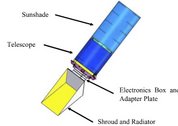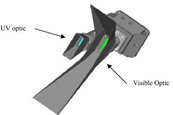The LROC is designed to address two prime measurement requirements: 1) Assess meter and smaller-scale features to facilitate safety analysis for potential lunar landing sites anywhere on the Moon; and 2) Acquire multi-temporal synoptic imaging of the poles every orbit to characterize the polar illumination environment (on a 100 m scale), identifying regions of permanent shadow and permanent or near-permanent illumination over a full lunar year. The LROC consists of two narrow-angle cameras (NACs) (see Fig. 1) to provide 0.5 m scale panchromatic images over a 5 km swath, a wide-angle camera component (WAC) (see Fig. 2) to provide images at a scale of 100 m in seven color bands over a 100 km swath in black and white mode and 60 km in color mode, and a common Sequence and Compressor System (SCS).
Fig. 1 LROC narrow angle Fig. 2 LROC wide angle
camera, 70 cm length by 24 cm camera,14.5 cm by 9.2 cm by 7.6 cm diameter
Each NAC has a 700 mm-focallength, that images onto a 5000-pixel CCD line-array, providing a cross-track field-of-view (FOV) of 2.86◦. The NAC readout noise is better than 100 e−, and the data are sampled at 12 bits, then compressed to 8-bit, square root encoded-values prior to downlink. The NAC internal buffer holds 256 MB of uncompressed data, enough for a fullswath image 25 km long or a 2×2 binned image 100 km long. The WAC has two short-focal-length lenses imaging onto the same 1000×1000 pixel, electronically shuttered CCD area-array, one imaging in the visible/near Infrared (EFL = 6.0 mm), and the other in the UV (EFL = 4.5 mm). The optical systems have a cross-track FOV of 90◦ and 60◦ respectively.
The NACs and WAC interface with the SCS, the third element of the LROC. As the name implies, the SCS commands individual image acquisition by the NACs and WAC from a stored sequence, and applies lossless compression to the NAC and WAC data as they are read out and passed to the spacecraft data system[8].

